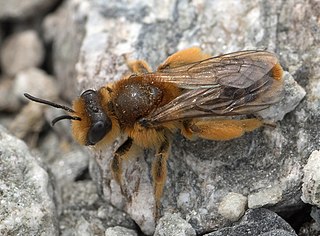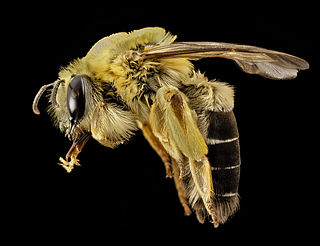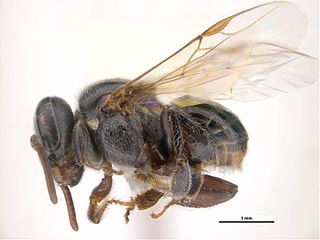
Carpenter bees are species in the genus Xylocopa of the subfamily Xylocopinae. The genus includes some 500 bees in 31 subgenera. The common name "carpenter bee" derives from their nesting behavior; nearly all species burrow into hard plant material such as dead wood or bamboo. The main exceptions are species in the subgenus Proxylocopa; they dig nesting tunnels in suitable soil.

Hylaeus is a large and diverse cosmopolitan genus within the bee family Colletidae. This genus is also known as the "yellow-faced bees". It is the only truly globally distributed colletid, with Hylaeus occurring on all continents except Antarctica.

The Stenotritidae is the smallest of all formally recognised bee families, with only 21 species in two genera, all of them restricted to Australia. Historically, they were generally considered to belong in the family Colletidae, but the stenotritids are presently considered their sister taxon, and deserving of family status. Of prime importance is that the stenotritids have unmodified mouthparts, whereas colletids are separated from all other bees by having bilobed glossae.

The cosmopolitan bee genus Ceratina, often referred to as small carpenter bees, is the sole lineage of the tribe Ceratinini, and closely related to the more familiar carpenter bees. They make nests in dead wood, stems, or pith, and while many are solitary, a number are subsocial, with mothers caring for their larvae, and in a few cases where multiple females are found in a single nest, daughters or sisters may form very small, weakly eusocial colonies. One species is unique for having both social and asocial populations, Ceratina australensis, which exhibits all of the pre-adaptations for successful group living. This species is socially polymorphic with both solitary and social nests collected in sympatry. Social colonies in that species consist of two foundresses, one contributing both foraging and reproductive effort and the second which remains at the nest as a passive guard. Cooperative nesting provides no overt reproductive benefits over solitary nesting in this population, although brood survival tends to be greater in social colonies. Maternal longevity, subsociality and bivoltine nesting phenology in this species favour colony formation, while dispersal habits and offspring longevity may inhibit more frequent social nesting in this and other ceratinines.

Melipona is a genus of stingless bees, widespread in warm areas of the Neotropics, from Sinaloa and Tamaulipas (México) to Tucumán and Misiones (Argentina). About 70 species are known. The largest producer of honey from Melipona bees in Mexico is in the state of Yucatán where bees are studied at an interactive park called "Bee Planet" which is within the Cuxtal Ecological Reserve.

Leioproctus is a genus in the plaster bee family Colletidae. Its members are primarily found in Australasia and temperate South America, and include the most common native bees in New Zealand. It includes the following species:

Tetragonula is a genus of stingless bees. In 1961, Brazilian bee expert J.S. Moure first proposed the genus name Tetragonula to improve the classification system by dividing the large genus Trigona stingless bees into 9 smaller groups. About 30 stingless bee species formerly placed in the genus Trigona are now placed in the genus Tetragonula. These bees are found in Oceania, in countries such as Australia, Indonesia, New Guinea, Malaysia, Thailand, the Philippines, India, Sri Lanka, and the Solomon Islands. The most recent tabulation of species listed 31 species.

Caupolicana is a genus of bees in the family Colletidae, native to the Americas; most species are crepuscular in habit, visiting flowers only at dawn and/or dusk. There are over 50 known species, in 4 subgenera.

Sphecodes is a genus of bees from the family Halictidae, the majority of which are black and red in colour and are colloquially known as blood bees. Sphecodes bees are kleptoparasitic on other bees, especially bees in the genera Lasioglossum, Halictus and Andrena. The adults consume nectar, but because they use other bees' provisions to feed their offspring they do not collect pollen.

Anthidiini is a tribe of insects in the family Megachilidae. There are at least 40 genera and 840 described species in Anthidiini.

Protandrenini is a tribe of mining bees in the family Andrenidae. There are at least 12 genera and at least 380 described species in Protandrenini.

Diphaglossinae is a subfamily of bees in the family Colletidae. There are 9 genera and more than 130 described species in Diphaglossinae.

Austroplebeia is a stingless bee (Meliponini) genus in the family Apidae. The genus was erected by Jesus Santiago Moure in 1961. The genus comprises five described species endemic to Australia and New Guinea.Austroplebeia are more closed related to the African stingless bees than rest of the species found in Asia and Australia.
Scaptotrigona is a genus of bees belonging to the family Apidae.
Hypanthidium is a genus of bees belonging to the family Megachilidae.












